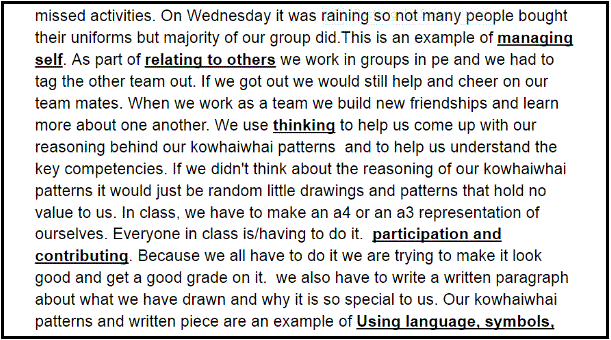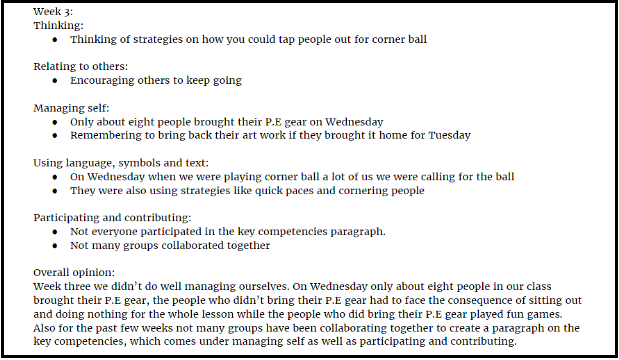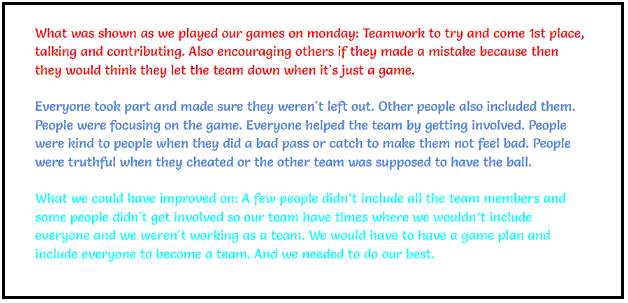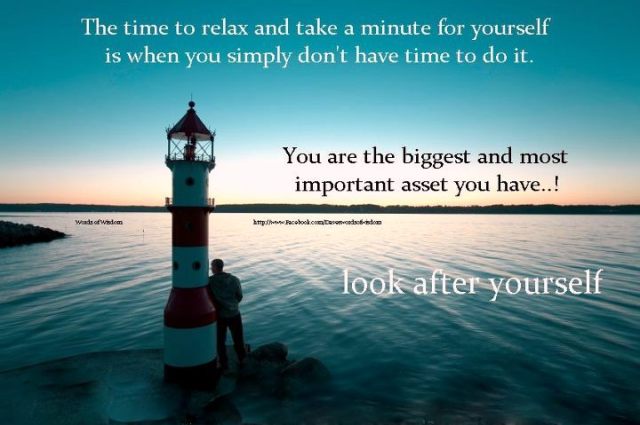John Dewey stated “We do not learn from experience…we learn from reflecting on experience.” (n.d.). This quote inspired and lead me to implement a digital and collaborative innovation based on reflective thinking and visible learning using the key competencies as a lens. The problem I identified was a gap in my practice that saw learning from year 9 and 10 separated from learning in years 11, 12 and 13. Many Health and Physical Education achievement standards involved with the National Certificate of Educational Achievement (NCEA) call for students to reflect on their performance, practice, actions or skills over a period of time. But while reflecting on my own practice, I realised that I had taken limited action to prepare learners in Year 9 and 10 for this next step in their learning. As the New Zealand Curriculum (2007) includes reflective and critical thinking as part of the lifelong learning process in its vision for the young people of Aotearoa, this was a definite area for improvement. Seeing the importance of this, our school has developed an Effective Teacher Profile as part of our Professional Learning Plan (2016) and the development of substantial collaborative skills is outlined clearly within this.
I wanted to introduce this innovation based on several key points. Resta & Laferrière (2007) infer that the use of technology to support collaborative learning fosters student engagement and develops higher order thinking skills for the learners involved. We are a Google Apps For Education school and the use of google docs to collaborate on the Key Competencies in Health and Physical Education allows learners to complete tasks in their own time and also work with others to construct ideas. This was intended to improve literacy skills across the board while also allowing for individuality and collaboration. Because I shared the particular class I trialled this innovation with, it was also a way to allow effective sharing of learning between myself and their other Health and Physical Education teacher.
Reflective practice as introduced by Jordi (2011) is a pedagogic tool used widely within a variety of learning activities and processes. He believes that reflection allows us to integrate a range of cognitive and non-conceptual elements that make up our experience and consciousness. Reflection needs to be introduced to learners as part of a lifelong process of how we think and learn. My feeling was that the task will likely never be complete as students begin a lifelong process and continue to reflect on their knowledge construction and application of the key competencies. Learners would start to understand in more detail, the deeper reasons for the learning.
The first concepts we had to work on was covering the background knowledge to allow this innovation to work. We looked at; what the Key Competencies actually were; introduced reflective thinking and the associated language; collaboration and the varying levels of collaboration as introduced by the Innovative Teaching and Learning (ITL) Rubric (SRI International, 2012). Students then needed to reflect individually at the end of (or during) each week on a shared google doc via Hapara and then collaborate on their learning to summarise the week. This did not simply mean that they would put all their reflections into a paragraph- they needed to discuss and decide what stays and what goes and potentially, what needs to be added to accurately describe their week in Health and Physical Education. This was where I hoped they would start to move towards interdependence as defined at level 4 and 5 of the Collaboration Rubric by SRI International (2012). At the start of each week, one group will feedback to the class their learning from the previous week.
Introducing the Key Competencies was easier than expected. Many students had knowledge of what they were and that left us time to unpack what they might look like in Health and Physical Education. This happened as a face to face conversation in small groups and as a class. This was highly effective with this group and allowed many ideas to be shared at the same time.
Introducing reflective thinking was more complicated and even through the introduction the what, so what? And now what? from Kolb’s Experiential Learning cycle (1984) many struggled to reflect on action as described by Schön (1991) and look towards their next learning steps. They were able to reflect in action but then interpreted that as and wrote it down after the fact as reflecting on action. What they did do was infer whether they had made ‘good’ or ‘bad’ choices in a particular competency area. I found this quite interesting as this had not come up in any discussion beforehand and 3 ako groups went down this path.
Situated Learning Theory, as described by Lave and Wenger (1991), involves teachers and students coming together to form communities of practice. Students are able to make sense of the learning and acquire knowledge through an authentic context in Health and Physical Education through learning in, through and about movement. My innovation is strongly based on situated learning where social interaction and collaboration are a required aspect of the learning. The concept of collaboration was not lost on this Year 9 group. They understood it perfectly. I utilised the ITL Rubric for collaboration to share with them the different levels of collaboration and the difference between that and cooperation. Two things really hindered progress in this area: time and access to devices. They have Health and Physical Education for three hours a week, of which I am with them for two hours. This means the collaboration must be online and after hours as the time we have together at school is already allocated to other learning. During the time I implemented this innovation, my school went from Bring Your Own Device (BYOD) to recommended BYOD. I had several students with no access to a device let alone an internet connection when they were not at school. This posed major difficulties for some to complete the reflections.
The impact of this innovation varied depending on who the various stakeholders were. The teacher I shared the class with echoed my own observations when she said time was a factor and we just seem to run out. She believed that the idea had merit and could work for her but this was currently not the case. She agreed that the work on the key competencies had made the learning visible for this class in practical sessions and this was definitely seen as a positive by all involved, including the students.
Students online collaboration is a skill that still needs to be developed. As discussed earlier, the lack of time and devices did have an impact on this innovation and needs to be addressed in order to improve the learning outcomes for students. Students were able to accurately reflect on their practice during lessons in a face to face forum but many struggled to put it into words on a google doc. I wonder if I was asking too much of them (in regards to their time) and should have given each person one competency to look at (instead of all of them at once) and then put them together via collaboration. I also wonder if google docs was the best digital tool to use. The use of padlet as a whole class may have been a better option.
In the class I tried this with, learners worked in one of five ako groups. The idea behind this was based around Social Development Theory (Vygotsky, 1962). Students are able to use their more skilled peers within their zone of proximal development to assist them with their learning (1987). The development of their reflective language skills and being able to internalise this drives their cognitive development. Thought and language will eventually become totally interdependent (Vygotsky, 1987). This is developing within the class and students sit at many different levels.
The three figures included below are screenshots taken from student ako groups show one week of their reflecting. It clearly shows that students were able to recognise the Key Competencies and how they related to their learning. It demonstrates that students reflecting skills are still developing. Some have demonstrated collaboration (figure 1 and 2) and some have merely put their thoughts onto a google doc separate from the rest of their group with no collective thinking (figure 3- one group member’s contribution). While talking to students, many saw a use for developing their reflective skills in order to understand the reasons for their learning while others saw it as a complete waste of time and were unable to link it to future learning with one even referring to it as “a bit hippy”. The next steps is developing the now what? aspect of the experiential learning cycle (Kolb, 1984) enabling students to look to the future.
 Figure 1.
Figure 1.
 Figure 2.
Figure 2.
 Figure 3.
Figure 3.
The summative result of implementing this innovation with my Year 9 class is they are far more aware of how the front end of the New Zealand Curriculum relates to their education and life as learners. They understand that the Key Competencies are a useful way to gauge their learning and reasons for learning. As stated earlier, my feeling is that this innovation will continue to evolve as my students do. As we find new ways of thinking and learning together, we will also find new ways to reflect. My key goal of making the learning visible through collaborative reflective practice will enable learners to know where they’ve been and where to go next in order to adapt to an ever changing world.
Reference List
Aotea College. (2016). Aotea College Professional Learning Plan 2016. Wellington: New Zealand: Aotea College.
Dewey, J. (2016). John Dewey Quotes. Retrieved from: http://www.goodreads.com/quotes/664197-we-do-not-learn-from-experience-we-learn-from-reflecting
Jordi, K. (2011). Reframing the Concept of Reflection: Consciousness, Experiential Learning and Reflective Learning Practices. Adult Education Quarterly. 61(2) 181-197. DO I 101177/074713610380439
Kolb, D. A. (1984). Experiential learning: Experience as the source of learning and development (Vol. 1). Englewood Cliffs, NJ: Prentice-Hall.
Lave, J., & Wenger, E. (1991). Situated Learning: Legitimate Peripheral Participation. Cambridge: Cambridge University Press.
Ministry of Education. (1999). Health and Physical Education in the New Zealand Curriculum. New Zealand, Wellington: Learning Media Limited.
Ministry of Education. (2007). The New Zealand Curriculum. New Zealand, Wellington: Learning Media Limited.
Resta, P., & Laferrière, T. (2007). Technology in Support of Collaborative Learning. Educational Psychology Review, 19, 65–83 DOI 10.1007/s10648-007-9042-7
Schön, D. A. (1991). The Reflective Practitioner: How Professionals Think in Action. United States of America: Basic Books Inc.
SRI International. (2012). Retrieved from http://www.itlresearch.com/images/stories/reports/21cld%20learning%20activity%20rubrics%202012.pd
Vygotsky, L. S. (1962). Thought and language. Cambridge MA: MIT Press.
Vygotsky, L. S. (1987). Thinking and speech. In R.W. Rieber & A.S. Carton (Eds.), The collected works of L.S. Vygotsky, Volume 1: Problems of general psychology (pp. 39–285). New York: Plenum Press.



 Figure 1.
Figure 1. Figure 2.
Figure 2. Figure 3.
Figure 3. Image source: http://quotesgram.com/take-time-to-relax-quotes/
Image source: http://quotesgram.com/take-time-to-relax-quotes/